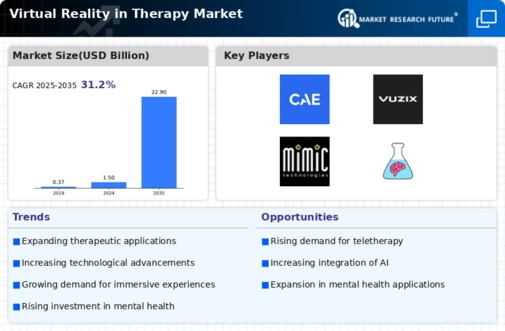Due to significant R&D investments made by the top market players to expand their product offerings, the market for virtual reality in therapy is expanding. Significant industry advancements can occur through various methods, including contracts, acquisitions, increased investment, and joint partnerships with other businesses. Major industrial corporations are creating several programs to broaden their impact globally. The Virtual Reality in Therapy Company must offer services at reasonable pricing if it wants to develop and thrive in a challenging and competitive industry.
Utilizing local manufacturing to cut operating costs is one of the main techniques businesses employ to satisfy clients and expand Virtual Reality in the Therapy market sector globally. Virtual Reality in Therapy market has recently substantially helped the Robotic Surgery business. Major corporations in the Virtual Reality in Therapy market, including Siemens Healthcare (Germany), Virtalis Ltd (U.K.), CAE Healthcare (U.S.), GE Healthcare (U.S.), Virtual Realities Llc (U.K.), and others, are trying to surge market demand by spending on research and development processes.
The CAE Inc. (CAE) Company designs, integrates, offers training solutions, and serves the aerospace and defense industries. The company offers services for aviation, training, integrated enterprise solutions, and workforce sourcing. Healthcare, Defense and Security, and Civil Aviation Training Solutions comprise CAE's three reportable segments that comprise its business operations. In 35 countries in the Americas, Europe, the Middle East, and Asia, the group has more than 200 locations. In March 2022, CAE Healthcare introduced CAE CathLabVR, a non-invasive cardiovascular simulator that offers realism for treating vascular and cardiac issues, with Microsoft HoloLens 2 connectivity.
GE Healthcare Technologies Inc. (GE HealthCare) is a leading global provider of medical devices, specializing in the design, development, production, and distribution of diagnostic imaging, clinical systems, drug discovery, biopharmaceutical production, cellular technologies, imaging agents for use in medical scanning, and a variety of healthcare IT products. Additionally, GE HealthCare offers services, including computerized data management, performance enhancement and performance solutions, and remote diagnosis and repair services for medical devices made by the business and others. The corporation uses subsidiaries and affiliates to run its operations worldwide. Chicago, Illinois, serves as the company's headquarters in the United States.
In November 2022, GE Healthcare worked with Mediview XR, Inc. to incorporate medical imaging into mixed reality technology to create the OmnifyXRTM Interventional Suite System.














